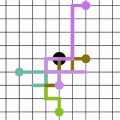We present a novel algorithm to identify potential dispersed signals of new physics in the slew of published LHC results. It employs a random walk algorithm to introduce sets of new particles, dubbed "proto-models", which are tested against simplified-model results from ATLAS and CMS (exploiting the SModelS software framework). A combinatorial algorithm identifies the set of analyses and/or signal regions that maximally violates the SM hypothesis, while remaining compatible with the entirety of LHC constraints in our database. Demonstrating our method by running over the experimental results in the SModelS database, we find as currently best-performing proto-model a top partner, a light-flavor quark partner, and a lightest neutral new particle with masses of the order of 1.2 TeV, 700 GeV and 160 GeV, respectively. The corresponding global p-value for the SM hypothesis is approximately 0.19; by construction no look-elsewhere effect applies.
翻译:我们提出了一个新的算法,以在已出版的LHC结果中找出新的物理可能分散的信号。它使用随机行算法来引入一系列称为“模型模型”的新粒子,这些粒子是用ATLAS和CMS(开发 SModelS 软件框架)的简化模型结果测试的。一个组合算法确定了一组最大程度违反SM假设的分析和/或信号区域,同时与我们数据库中所有LHC限制保持兼容。通过运行 SModelS 数据库的实验结果来展示我们的方法,我们发现目前最优秀的原型模型模型是顶级伙伴、一个光-flavor 石方伙伴和一个最轻的中性新粒子,其质量分别为1.2 TeV、700 GeV和160 GeV。 SM假设的相应全球P价值约为0.19;通过建设不看-eleswhere效果适用。




